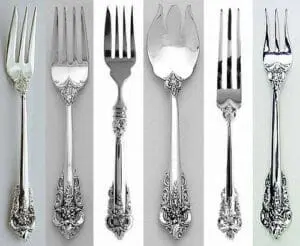The Salad Fork: A Guide to Dining Etiquette and More

Everything related to the table setting can be beautiful yet highly intimidating, especially in formal dining. The salad fork is sometimes perceived quite ambiguously in the cutlery presented. What sets it apart? How is it used? And why does it even exist? To see what happened to the salad fork, let’s examine unappealing dining etiquette.
The Purpose of a Salad Fork
The salad fork is a fork used solely for handling salads. It measures about the size of a dinner fork but is slightly smaller and approximately 6 inches long. Its tines are somewhat broader and often designed differently; one or two outer tines might be thicker or notched to aid in handling fibrous foods like lettuce, vegetables, or other salad ingredients.
The first role of the salad fork –and the most apparent– is utilitarian and related to the protocol. How meals are constructed and described in a formal dining setting, how each dish is delivered in courses, and how each course, together with the dishes served, has its own utensils. The salad fork enables the user to eat the salad without switching a wrong for initially intended for the other course, say the main course.
The History of the Salad Fork
There is nothing new to investing in; it is as old as history. Regarding the use of utensils in the Middle Ages and then during the Renaissance and Victorian periods, dining was translated more as the art of eating with special utensils for each type of food. From this trend of thought came the salad fork and, with it, the prospect of both function and rank.
In the 19th century, it was strengthened as the fairest utensil for arranging the table setting and serving meals, preferably in Western countries. Its design became more appropriate for different salads, from the basic green salad to those with meats, cheese, or nuts. Every detail and side of the utensil was designed to improve presentation and serving, all within the dictated etiquette standards.
Identifying the Salad Fork
The salad fork is placed to the left of the dinner fork on the table for regular formal dining. The general rule is that utensils are brought in from outside while serving courses, and the salad fork is placed accordingly, mainly because salad is usually the first course.
Here are some tips for identifying a salad fork:
- Size: It is smaller than the dinner fork but more than the dessert fork.
- Tines: The tines may be thicker and spread out, or the basal halfway is slightly serrated.
- Placement: Located at the outermost left if a salad course precedes the main course.
Using the Salad Fork
Even the correct positioning of a salad fork seems obvious; however, some ways can help one become more polite at the table in formal ceremonies. Place the fork across the palm of the dominant hand, with the prongs facing the air. If salad is part of several courses, a different serving utensil for each dish is advisable.
This can also cut through foods with large leaves or other problematic ingredients in salads. Sometimes, a machete is also present for reinforcement.
Coporary Transformations and Functions
Although the salad fork was once a standard eating utensil, changing eating habits and trends itss use. Most folks still use salad forks for other light meals, including appetisers and sometimes fruit. As a result, it can be considered a perfect solution for families for families for whom it can be a daily table. staple
However, some current tableware designs have brought about some convergence between speciaspecializedils. But currently the salad fork is accented and occupies a separate niche as a practical utensil, especially during official dinners.
Why the Salad Fork Matters
The knowledge of the purpose and usage of the salad fork is not limited to the following but goes a notch higher. It is cultural, traditional, and detail-oriented. Mastering such information can help achieve a favourable outcome in professional or informal meetings, recognising the importance of etiquette.
Conclusion
The salad fork might not be so prominent in the grand dining population, but it is a factor. This utensil can be considered functional and formal from the historical usage perspective to the line designed on it. It’s every man for himself in the dining culture world and therefore makes it imperative that one learn and employ the correct etiquette properly; a case in point being the proper manner for using the salad fork where the distinction of separating from or twining it with the dinner fork is made.





